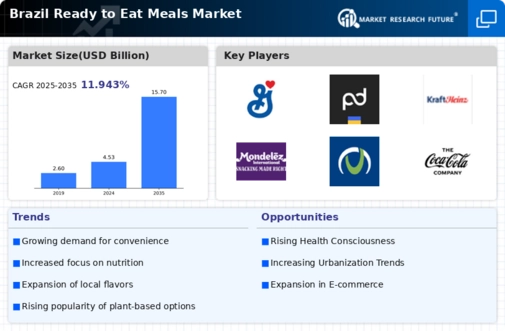Rising Disposable Incomes
Brazil has experienced a gradual increase in disposable incomes over the past few years, which seems to correlate with a heightened interest in premium ready to-eat meal options. As consumers gain more financial flexibility, they are likely to invest in higher-quality, gourmet meals that provide both taste and convenience. Market data suggests that the ready to-eat-meals market has seen a growth rate of approximately 10% annually, driven by this increase in disposable income. Consumers are increasingly willing to pay a premium for meals that not only save time but also enhance their dining experience, thereby influencing the overall dynamics of the ready to-eat-meals market.
Changing Dietary Preferences
The evolving dietary preferences among Brazilian consumers are significantly impacting the ready to-eat-meals market. There is a noticeable shift towards plant-based and organic meal options, driven by health consciousness and environmental concerns. Recent surveys indicate that nearly 30% of consumers in Brazil are actively seeking vegetarian or vegan ready to-eat meals. This trend suggests that manufacturers must adapt their offerings to cater to these changing preferences, thereby expanding their market reach. The ready to-eat-meals market is likely to benefit from this diversification, as it aligns with the growing demand for healthier and more sustainable food choices.
Urbanization and Busy Lifestyles
The rapid urbanization in Brazil has led to an increase in the number of individuals living in metropolitan areas, where lifestyles are often fast-paced. This trend appears to drive the demand for convenient food options, particularly in the ready to-eat-meals market. As more people work long hours and commute extensively, the need for quick meal solutions becomes paramount. According to recent data, approximately 85% of urban dwellers in Brazil express a preference for meals that require minimal preparation time. This shift in consumer behavior indicates a growing reliance on ready-to-eat meals, which offer both convenience and variety, propelling the market forward.
Technological Advancements in Food Production
Technological innovations in food production and preservation are playing a crucial role in shaping the ready to-eat-meals market. In Brazil, advancements such as improved packaging techniques and better supply chain logistics have enhanced the quality and shelf life of ready to-eat meals. These innovations allow manufacturers to offer fresher products that retain their nutritional value, appealing to health-conscious consumers. Furthermore, the integration of e-commerce platforms has made it easier for consumers to access a wider variety of ready to-eat meals. This technological evolution is likely to continue driving growth in the ready to-eat-meals market, as it meets the demands of a modern consumer base.
Increased Focus on Convenience and Time-Saving Solutions
In Brazil, the increasing focus on convenience and time-saving solutions is a pivotal driver for the ready to-eat-meals market. As more individuals juggle work, family, and personal commitments, the demand for meals that can be prepared quickly and easily is on the rise. Market analysis indicates that around 70% of Brazilian consumers prioritize convenience when selecting food options. This trend is further amplified by the busy lifestyles of urban populations, who often prefer meals that can be consumed on-the-go. Consequently, the ready to-eat-meals market is likely to expand as it aligns with the needs of consumers seeking efficient meal solutions.
























Leave a Comment